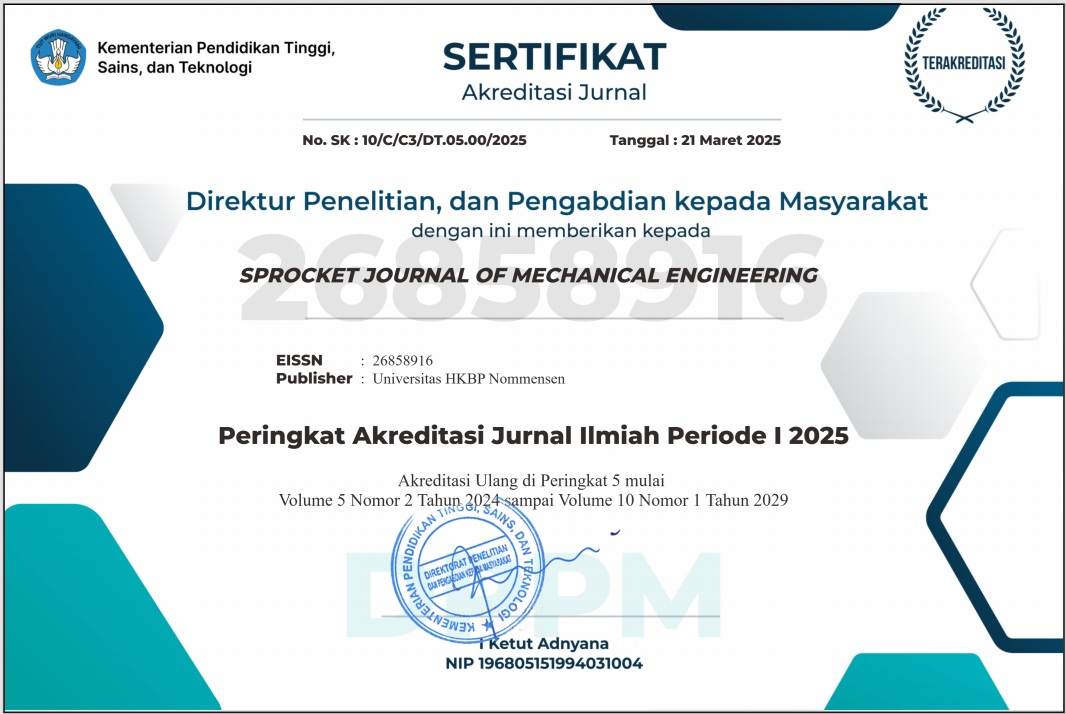Analisis Kinerja Dan Efisiensi Energi Mesin Water Cooled Chiller Di Gedung Capital Place Tower Jakarta
Abstract
This study aims to calculate the COP (Coefficient of Performance) value of the chiller and determine whether the value is better than the standard value. The analysis includes taking data on temperature, pressure, evaporator and condenser water flow, amperage and voltage in the compressor on the chiller, then calculating the COP to determine the efficiency of the chiller machine performance. The results of the calculation state that the highest COP value of chiller No. 2 is 7.4 and the lowest is 7.0 in the efficient category referring to the chiller standard of 7.22. While the highest COP of chiller no. 3 is 7.4 and the lowest is 5.1 in the inefficient category referring to the chiller standard of 7.22. The results of the calculation of the capacity of chiller No. 2 at 100% compressor load, the resulting cooling capacity is only 77.29-90%, the potential for increasing efficiency that can be optimized in chiller No. 2 is 22.71-39.38%. Chiller No. 3 at 100% compressor load produces only 83.34-66.89% of the cooling capacity, while the potential efficiency increase that can be optimized in chiller No. 3 is 33.11-37%. To increase chiller efficiency, set the chilled water temperature setpoint not too low between 7-80C adjusted to actual needs, load changes and environmental conditions.
References
[1] Pudjanarsa, Astu, Ir., MT dan Djati Nursuhud, Prof. 2013. Mesin Konversi Energi (Edisi ke-3). Yogyakarta: [PENERBIT ANDI].
[2] Rohman, J. (2023). “Analisis Kinerja Refrigasi Water Chiller Pada Pengkondisian Udara di Gedung WTC Mangga Dua Jakarta.”. Universitas Tidar.
[3] Andrean, M., Wijana, T., & Rachmanto, T. (2023). “Analisa Penggunaan Energi Elektrik Dan Biaya Pada Mesin Chiller Di Transmart Kota Bandung.”. Universitas Mataram. 6(2).
[4] Rindika, Asep., & Saputra, Indra. (2020). “Analisa Performansi Tipe Water Cooled Chiller Centrifugal Kapasitas 2000 TR Pada Gedung Central Park Mall Jakarta Barat”. Politeknik Negeri Balikpapan. ISBN: 978-602-51450-2-5.
[5] Ardiansyah, Rozi., & Suryadimal. (2021). “Analisa Kinerja Mesin Pendingin Mini Water Chiller Dengan Aliran Silang Pada Evaporator Kapasitas 1 1/2 PK.”. Universitas Bung Hatta.
[6] Syahputra, Sofyan Anwar., Fadlan S., & Joel P. (2021). “Perbandingan Coefficient Of Performance (COP) Chiller Water Cooled Dengan Air Cooled”. Universitas Cut Nyak Dhien. Vol. 2 No.1.
[7] Samudra, Bambang Jaka., Maryadi, & Amiral Aziz. (2021). “Detail Desain Chiller Sistem HVAC Pada Bangunan Gedung Bertingkat”.Universitas Islam As-Syafi’iyah.Vol.03 No.1.
[8] Syahputra, Hendrik. (2021). “Kaji Ekxperimental Performansi Mesin Pendingin Tipe Chiller Untuk Cold Storage dan Indoor Menggunakan Coolant Ethylene Glycol”. Universitas Riau.
[9] Mahardika, Yoval Sulthan. (2022). “Analisis Pengaruh Freon R-123 dan R-134a Pada Engine Chiller Di Kapal KM. Portlink”. Politeknik Ilmu Pelayaran Makassar.
[10] Cappenberg, Audri Deacy. (2020). “Analisis Chiller Dengan Menggunakan R123 dan R134a Pada Kinerja Pendiginan”. Universitas 17 Agustus 1945 Jakarta. Vol. 5 No.1.
[11] Ir. Ali Mahmudi, M. E. (2006). “Buku Bahan Ajar Pompa Dan Kompresor”. 11.
[12] Septian. (2024). “Operator Training Trane Centrifugal Chiller Model CVHE/G Capital Place Tower Jakarta”. PT. Trane Indonesia.

This work is licensed under a Creative Commons Attribution 4.0 International License.
Penulis yang menerbitkan dengan SPROCKET JOURNAL OF MECHANICAL ENGINEERING menyetujui ketentuan berikut :
- Penulis memegang hak cipta dan memberikan jurnal hak penerbitan pertama dengan karya yang dilisensikan secara bersamaan di bawah Lisensi Internasional Creative Commons Atribusi 4.0 . yang memungkinkan orang lain untuk berbagi karya tersebut dengan pengakuan atas kepengarangan karya dan penerbitan awal dalam jurnal ini.
- Penulis dapat membuat pengaturan kontraktual tambahan yang terpisah untuk distribusi non-eksklusif atas versi jurnal yang diterbitkan dari suatu karya (misalnya, mempostingnya ke repositori institusional atau menerbitkannya dalam sebuah buku), dengan pengakuan atas penerbitan awalnya di jurnal ini.
- Penulis diizinkan dan didorong untuk mengunggah karya mereka secara daring (misalnya, di repositori institusi atau di situs web mereka) sebelum dan selama proses penyerahan, karena hal ini dapat mengarah pada pertukaran yang produktif, serta kutipan yang lebih awal dan lebih banyak dari karya yang diterbitkan (Lihat Pengaruh Akses Terbuka ).





.png)
.png)

